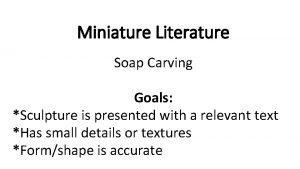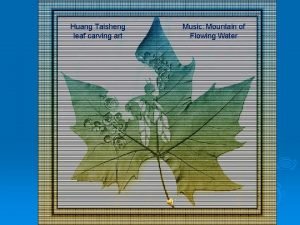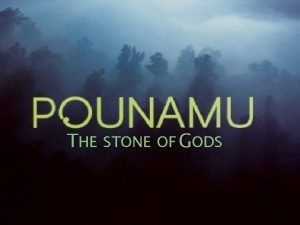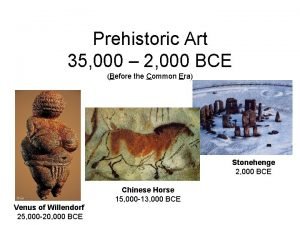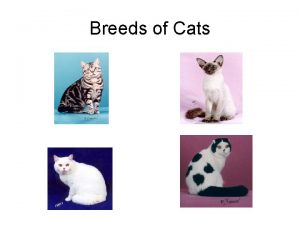CARVING CARVING One of the oldest types of


















- Slides: 18

CARVING

CARVING • One of the oldest types of art and it’s an art-form common to all cultures • Is the act of using tools to shape something from a material by scraping away portions of that material. The technique can be applied to any material that is solid enough to hold a form even when pieces have been removed from it, and yet soft enough for portions to be scraped away with available tools.

• Wood was the principal type of African sculpture used to produce masks, statuettes, religious objects and general decorative items. The medium was also widely used in Oceanic art for the carving of ceremonial canoes and other objects, as well as in the totem pole culture of American Indian art and in the Aboriginal art of Australia.

African sculpture • Ceremonial Mask

Oceanic art • Ceremonial canoes

American Indian art and in the Aboriginal art of Australia. • Totem pole

• Wood is the common medium in carving but being water absorbent and vulnerable to insects and airborne fungi, wood can degrade quite rapidly. As a result, bronze, marble and other types of stone have been preferred for monumental works.

• Example of STONE CARVING

HISTORY

Prehistoric Sculpture • Experts have traditionally believed that the earliest sculpted objects, cut from ivory, horn, bone, or stone, dated from about 27, 000 to 32, 000 years ago. But discoveries in the early 2000 s suggest that prehistoric people in Africa began carving objects even earlier. In 2006 Norwegian researchers reported finding a rock in a cave in Botswana that resembles the head of a python, an animal important in the rituals of the San people. The rock has markings made by humans and appears to date from about 70, 000 years ago.

Venus of Willendorf • This so-called Venus figurine from the area of Willendorf, Austria, is one of the earliest known examples of sculpture, dating from about 23, 000 BC. The figure, which is carved out of limestone, is only 11. 25 cm (4. 5 in) high, and was probably designed to be held in the hand. It is believed the Venus may be a fertility symbol, which would explain the exaggerated female anatomy.

Egyptian Sculpture • Among the oldest Egyptian sculptures is a piece of slate carved in low relief, known as the Palette of King Narmer (3100? BC), Egyptian Museum, Cairo). It portrays the victory of Upper over Lower Egypt, depicting the kings, armies, servants, and various animals. The kings (pharaohs) were also commemorated in magnificent life-size statues, set in funerary temples and tombs (see Egyptian Art and Architecture). Not true portraits, these sculptures are idealized representations, immobile of features and always frontal in pose. Strong geometric emphasis was given to the body, with the shoulders and chest plane resembling an inverted triangle, as in a carved diorite sculpture (2500? BC, Egyptian Museum) of the pharaoh Khafre. During the reign of Akhenaton, greater naturalism of representation was attained, as seen in the exquisite painted limestone portrait bust (1350? BC, Staatliche Museen, Berlin) of his queen Nefertiti.

Egyptian Sculpture of Khafre • This seated stone figure of Egyptian king Khafre, from the 2500 s BC, was carved from a solid block of diorite, the hardest stone available at the time of the Old Kingdom in Egypt. The piece stands 165 cm (66 in) high and is an idealized representation of the king, with strong geometric lines and dramatic proportions.

Aegean and Greek Sculpture • Aegean art includes Minoan sculpture, such as terra-cotta and ivory statuettes of goddesses, and Mycenaean works, consisting of small carved ivory deities. The Greeks, masters of stone carving and bronze casting, created some of the greatest sculpture known. Working on a monumental scale, they brought depiction of the human form to perfection between the 7 th and 1 st centuries BC.

Strangford Apollo • The Strangford Apollo is a marble kouros figure (statue of a young man) from Anaphe, Greece. It was carved around 500 BC, toward the close of the Archaic period. Its anatomy is more naturalistic than earlier Archaic figures.

Terra-Cotta Tomb Figures • More than 6, 000 life-size terra-cotta soldiers and horses were produced for the tomb of the first Chinese emperor, Qin Shihuangdi. The figures remained buried near his burial mound from 210 BC until their discovery in 1974. These highly individualized armed figures reveal not only a great degree of artistic achievement, but also a disregard for the human and capital costs that characterized the Qin

ROMAN SCULPTURE • The Romans were avid collectors and imitators of Greek sculpture, and modern historians are indebted to their copies for knowledge of lost Greek originals. Their distinctive contribution to the art of sculpture was realistic portraiture, in which they recorded even the homeliest facial details. The Romans’ sense of the importance of historic events is evident in many sculptured commemorative monuments in Rome, such as the Arch of Titus (AD 81? ), Trajan’s Column (106? -113 AD), and the equestrian statue of Marcus Aurelius (175? ); the last- named became the prototype for most later equestrian sculptures. See Etruscan Civilization: Art and Architecture; Roman Art and Architecture.

Marcus Aurelius, AD 175 • This statue of Roman Emperor Marcus Aurelius became the inspiration for centuries of later artists portraying military and civic leaders on horseback. The authoritative bronze statue stands on the Campidoglio, Rome, Italy.
 Britan
Britan John agard history
John agard history Purdue pumpkin carving stencil
Purdue pumpkin carving stencil Soap literature
Soap literature Leaf carving art
Leaf carving art Analyzing one variable data
Analyzing one variable data Rockler bench dogs
Rockler bench dogs Kia karakia
Kia karakia What era
What era Waves dropping sand on the beach is an example of what
Waves dropping sand on the beach is an example of what Incised carving
Incised carving Chapter 24 world war looms
Chapter 24 world war looms One empire one god one emperor
One empire one god one emperor One one little dog run
One one little dog run One king one law one faith
One king one law one faith Byzantine definition
Byzantine definition Ford one plan
Ford one plan See one do one teach one
See one do one teach one See one, do one, teach one
See one, do one, teach one



